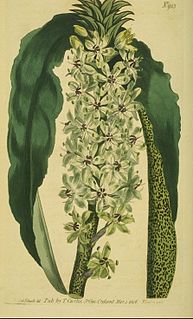
Eucomis comosa, the pineapple flower, pineapple lily or wine eucomis, is a species of flowering plant in the asparagus family Asparagaceae. A deciduous bulbous perennial used as an ornamental plant, it is endemic to South Africa. The white to purple flowers appear in summer and are arranged in a spike (raceme), topped by a "head" of green leaflike bracts.
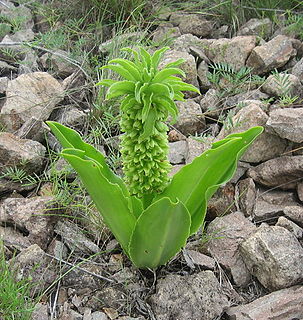
Eucomis is a genus of flowering plants in the family Asparagaceae, subfamily Scilloideae, native to southern Africa. Most species of this genus are commonly referred to as pineapple flowers or pineapple lilies. They are bulbous perennials with basal rosettes of leaves and stout stems covered in star-shaped flowers with a tuft of green bracts at the top, superficially resembling a pineapple – hence the common names.

Eucomis autumnalis, the autumn pineapple flower, or autumn pineapple lily, is a species of flowering plant in the family Asparagaceae, subfamily Scilloideae, native to Malawi, Zimbabwe and southern Africa. It is a mid to late summer flowering deciduous bulbous perennial. The flower stem reaches about 40 cm (16 in), rising from a basal rosette of wavy-edged leaves. The green, yellow or white flowers are arranged in a spike (raceme), topped by a "head" of green leaflike bracts. It is grown as an ornamental garden plant and can also be used as a cut flower.

Eucomis vandermerwei is a South African bulbous perennial flowering plant, a member of the asparagus family, and like other members of Eucomis is commonly known as pineapple lily for its superficial resemblance to that plant, although not closely related to it. This species is one of the smallest in the genus, and is native to a high-rainfall region of western Mpumalanga in South Africa. The dense rosette of leaves, either prostrate or ascending, is heavily blotched with purple, and the leaf-edges are markedly crisped or wavy. The star-shaped burgundy flowers appear in midsummer, and are borne on a spike (raceme) topped by a "head" of leafy bracts.

Ts'ehlanyane National Park is a National Park in Lesotho. It is located in the Maloti Mountains in Leribe District, and is part of the larger Maloti-Drakensberg Transfrontier Conservation Area. This Lesotho northern park protects a high-altitude, 2,600-metre (8,500 ft) patch of rugged wilderness, including one of Lesotho’s only stands of indigenous forest with a number of rare undergrowth plants that are unique to this woodland habitat.

Eucomis bicolor, the variegated pineapple lily or just pineapple lily, is a bulbous species of flowering plant in the family Asparagaceae, subfamily Scilloideae, native to Southern Africa. The pale green, purple-margined flowers are arranged in a spike (raceme), topped by a "head" of green leaflike bracts. It is cultivated as an ornamental bulbous plant, although its flowers have an unpleasant smell, attractive to the main pollinators, flies.

Eucomis pallidiflora, the giant pineapple lily, is a bulbous species of flowering plant in the family Asparagaceae, subfamily Scilloideae, native to southern Africa. The white to green flowers appear in summer and are arranged in a spike (raceme), topped by a "head" of green leaflike bracts. Some forms reach almost 2 m when in flower. The species is cultivated as an ornamental plant, although it is not hardy in areas where severe frosts occur.

Eucomis zambesiaca is a bulbous plant in the family Asparagaceae, subfamily Scilloideae, native to southern Africa, from Zimbabwe through Malawi to the Limpopo Province of South Africa. One of the smaller species in the genus, it has a rosette of leaves about 45 cm (18 in) across and white flowers in a spike to about 30 cm (12 in) tall.
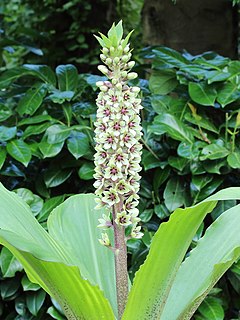
Eucomis montana is a plant species in the family Asparagaceae, subfamily Scilloideae, found in South Africa and Eswatini (Swaziland). When in flower in summer, the plant reaches a height of up to 45 cm, with a dense spike (raceme) of greenish flowers, topped by a "head" of green bracts.

Albuca humilis is a bulbous flowering plant, placed in the genus Albuca in the subfamily Scilloideae of the family Asparagaceae. It is native to southern Africa – to South Africa from the Free State to KwaZulu-Natal according to some sources, or to the Drakensberg Mountains of Lesotho according to others.
Graham Dugald Duncan(born 1959) is a South African botanist and specialist bulb horticulturalist at the Kirstenbosch National Botanical Garden, Cape Town, South Africa.

Leucospermum muirii is a rounded, upright, evergreen shrub of about 1½ m (5 ft) high, with a single trunk at its base, that is assigned to the Proteaceae. The flowering branches are 2–3 mm (0.079–0.118 in) thick and are initially grey due to a covering of fine crinkly hairs, which are soon lost. The very narrow spade-shaped leaves of about 5 cm (2 in) long and ¾ cm (0.3 in) wide carry three to seven teeth, and also quickly lose their soft layer of hairs. Its smallish globe-shaped flower heads of 2–3 cm (0.8–1.2 in) in diameter occur with one to four together, each on a stalk of 1–2 cm (0.4–0.8 in) long. It has pale to greenish yellow flowers, becoming orange with age, with some long hairs near their tips, from which straight styles stick out. This gives the flower head the likeness of a pincushion. It flowers from July till October and is pollinated by birds. It is called Albertinia pincushion in English and bloukoolhout in Afrikaans. It is an endemic species that can only be found near Albertinia in the very south of the Western Cape province of South Africa.
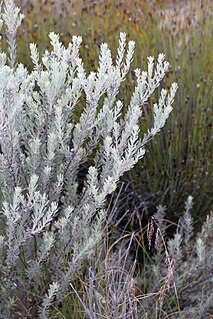
Leucospermum royenifolium is an evergreen, spreading or somewhat upturning shrub of up to ½ m high and 1–3 m (3–10 ft) in diameter from the family Proteaceae. It has patent elliptic, eventually hairless leaves. The flower heads are globe-shaped, 1–2 cm (0.4–0.8 in) in diameter, and contain initially whitish, later pinkish, sweetly scented flowers. From the center of the flowers emerge almost straight styles that jointly give the impression of a pincushion. It is called eastern pincushion in English. It can be found flowering between July and December. It occurs in the Western Cape and Eastern Cape provinces of South Africa.

Leucospermum pedunculatum is an evergreen, low shrub of 15–30 cm (½–1 ft) high spreading from a single stern upright stem, from the family Proteaceae. The powdered or hairless line-shaped to somewhat sickle-shaped leaves are 3–6 cm (1.2–2.4 in) long and 2–5 mm (0.08–0.20 in) wide. The stalked, individually set flower heads are globe-shaped, 2½−3 cm in diameter consist of initially white to pale cream flowers that eventually turn carmine. From the center of the flowers emerge straight styles that jointly give the impression of a pincushion. It is called white-trailing pincushion in English. It flowers from August to January, peaking in September. It is an endemic species that is restricted to a narrow strip on the south coast of the Western Cape province of South Africa.
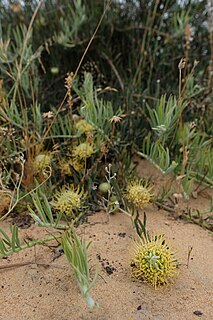
Leucospermum arenarium is a lax, evergreen shrub, with arching and drooping branches, that has been assigned to the family Proteaceae. It has loosely spaced, upright, greyish, narrowly egg-shaped to line-shaped leaves, mostly without teeth and flattened globe-shaped flower heads of 5–7 cm across, consisting of mostly creamy, seldom yellow flowers, that curve in the bud to the center of the head. From the center of the flowers emerge curved styles that jointly give the impression of a pincushion. The common name in English is Redelinghuys pincushion. It only occurs in a very small area in the Western Cape province of South Africa. It flowers between July and October. Unlike in related species the flowers are pollinated by hairy-footed gerbils and striped field mice.
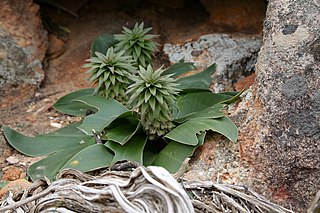
Eucomis regia is a species of bulbous flowering plant in the family Asparagaceae, subfamily Scilloideae, native to the Cape Provinces of South Africa. It is sometimes cultivated, but requires protection in a greenhouse in temperate climates.
Eucomis amaryllidifolia is a species of flowering plant in the family Asparagaceae, subfamily Scilloideae, native to the Cape Provinces. It is a short, summer-flowering bulbous plant, with a dense spike (raceme) of yellowish-green flowers topped by a "head" of leafy bracts. In Afrikaans it is called kliplelie.
Eucomis humilis is a species of flowering plant in the family Asparagaceae, subfamily Scilloideae, native to KwaZulu-Natal and Lesotho. It was first described by Baker in 1895. The greenish to purplish flowers appear in summer and are arranged in a spike (raceme), topped by a "head" of green leaflike bracts. Cultivated as an ornamental plant, it can be grown successfully outside where frosts are not too severe.
Eucomis schijffii is a bulbous species of flowering plant in the family Asparagaceae, subfamily Scilloideae, native to the Cape Provinces, KwaZulu-Natal and Lesotho. It was first described by William Frederick Reyneke in 1976. The reddish purple flowers appear in summer and are arranged in a spike (raceme), topped by a "head" of green leaflike bracts. It is cultivated as an ornamental plant and can be grown successfully outside where frosts are not too severe. The smallest of the species of Eucomis, it is particularly suited to being grown in rock gardens or containers.
Protea dracomontana, the Nyanga protea or the Drakensberg sugarbush, is a flowering plant that belongs within the genus Protea. The plant is found in the Eastern Cape, Lesotho, KwaZulu-Natal and the escarpment of the Free State, as well as eastern Zimbabwe. In Zimbabwe this species is only known from a disjunct subpopulation confined to the summit of Mount Nyangani.













